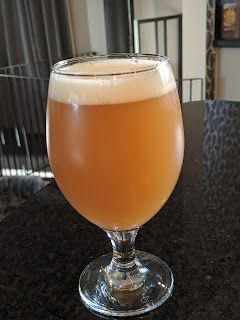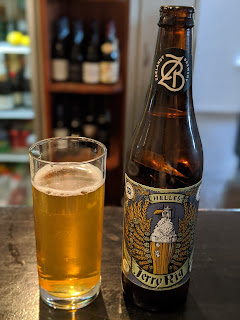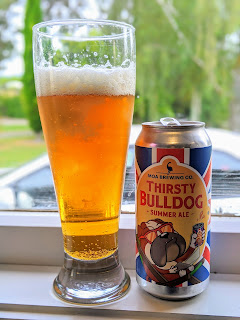The Tooth Ferry White IPA
First crack at a White IPA. Not sure why I got obsessed with making one of these, but I did. I made a Belgian Wit years ago (my second or third ever all grain brew) and it was bloody good. I usually stick to basic ingredients and on principal don't like adding fruit, herbs or spices to beer, and very, very rarely use non-barley grains; so a Belgian Wit is quite different for me, and therefore I've gone a bit nuts (well, for me anyway) and added all the classical Wit-bits. Orange zest (couldn't get Tangelo thanks very much COVID-19), coriander seeds, chamomile, wheat and oats. That's more than double the usual repitoire of four ingrediants, with an extra five. So I guess what I'm trying to get at is, I'm brewing out of my comfort zone, and I have no idea what I'm doing.
I do love a good Witbier. The classic (but not the best) is Hoegaarten (which I spent a lot of time drinking in Belgian Beer Gardens in Melbourne my early twenties), and actually I was a big fan of Mac's Great White, which was a kiwi made Witbier (as far as I'm aware they don't make it any more). A good Wit is a bit sweet, a bit spicy, some distinctive aromas somehow similar but yet very different from a German wheat beer (Hefeweizen - with it's big banana and clove flavours - all derived from the yeast with no added bits and bobs). Like its German counterpart, there is a huge contribution from the yeast giving it a distinctive flavour, but under that is the silky smoothness from the oats, the citruisy punch (coming from actual citrus rather than hops), and perhaps a subtle spiciness from coriander. Historically (I take no responsibility for the accuracy of this statement) the Belgian monks left Germany to be free of the German Purity Law (Reinheitsgebot) which allowed them to add whatever the hell they wanted into beer (which was illegal in Germany). Hence the addition of coriander, orange peel and chamomile. Wheat makes the beer kind of soft and light and often a bit hazy, while oats give almost a creamy texture (these days common addition in the Hazies / NEIPAs). Actually while I mention the Hazy IPAs, there is a huge overlap between White IPAs and NEIPAs, both using a similar grain bill (with lots of wheat and some oats), and a big hoppy flavour.
Another beer history legend (again, I take no responsibility for the accuracy of this story, and perhaps I'll even improvise some parts of it) is that two American head brewers (heads of the breweries, not guys that brew heads) were sitting down having a yarn over some beers. One brewed big Belgian styles and was well known for his spiced Witbier; the other brewed big American styles and was renouned for his overwhelmingly hoppy APAs. After several beers they came up with the idea to combine the two styles, and hence the White IPA was born. At this point they probably had several more beers, and then agreed upon a recipe. They then both went back to their own breweries (perhaps not the same night, but who knows) and both simultaneously made a different version of the "original" White IPA. Both tasted completely different, but were both amazing. And hence the style was born. It's now an officially recognised BJCP beer style.
I grab a White IPA whenever I see one. Locally, Moa make one (which is the first one I ever tasted, and I loved it), Macs make one (but I think it's seasonal, so might not be around anymore), and a few of the more craft breweries make them as seasoals. It's not a particularly popular style, and I can see why - I wouldn't drink it every day, and it's a bit heavy for Summer but a bit fruity for Winter, but still goes down a treat when you're in the right mood. Many of the crafty local White IPAs I've tried recently have had more of a NEIPA/Hazy IPA feel being super mega hopified, but not really letting any of the Witbier flavours come through. Others, like the Macs one, have a yum Witbier feel, but aren't quite hoppy enough.
My goal here is to get a big unmistakable Witbier flavour that survives under a big NZ hop flavour. I'm using all three techniqes to add a big hop aroma - late boil addition, whirlpool/hopstand, and dry hopping. I'm using the "dry hop saturation" rule (scientifically proven apparently) of 8g/L to use the maximum amount of useful dry hopping (160g for a 20L batch) with some of the new Trial Hops (not yet named) as well as Wai Iti (because my favourite hoppy beer at the moment is the Wellingtonian by Fortune Favours, which has a completely unique amazing hops aroma, I think due to Wai Iti); and I'm using Nelson Sauvin for a little bittering and a big late boil addition. Hopefully a massive NZ hop smell and flavour, enhancing but not fighting with the orange zest, coriander, chamomile, and Belgian yeast flavours... Ambitious as heck. But if it works...
Also a note on yeast - I've used a Belle Saison yeast here, which I've used before. I could have used a liquid Wit yeast (I haven't used a dry yeast in years), but I've used this Belgian yeast before in my first attempt at a Wit, and I loved it. I'm also planning to re-pitch it shortly in a mead, and I figured this would have more diversity in future beers (I have a conical fermenter and like to keep my yeasts for re-use).
And finally the name - Tooth Ferry. My three year old son surprised us when he was arguing with his sister that the Tooth Fairy isn't a small lady with wings, but rather a flying boat that takes your teeth. We realised after a while that he thought it was a Tooth Ferry rather than a Tooth Fairy.
Ingredients
Fermentables
- 3kg Gladfield Pilsner Malt
- 1kg Gladfield Munich Malt
- 2kg Flaked Wheat
- 200g Rolled Oats
- 100g Nelson Sauvin cones (20g first wort hop [90 min boil] / 80g - 5 min boil)
- 100g Trial Hop 4337 pellets (40g whirlpool starting at 90C for 15 mins / 60g dry hop)
- 100g Wai Iti pellets dry hop
Uncooth Additions
- 10g Ground coriander seeds - 5 min boil
- 30g Orange zest (4 biggish oranges) - 5 min boil
- 30g Chamomile tea (chopped the teabags open to get 30g of actual tea) - 5 min boil
- Belle Saison Dry Yeast
Starter
1.5L water + 250g light DME
3 days, bubblin' like crazy
Mash
Single infusion mash
Strike water 18L at 77C (target 68C)
Mash 90 mins
First runnings 12L (first wort hop with 20g Nelson Sauvin cones)
12L Single sparge (just used hot tap water, about 65C, maybe a bit colder)
Boil
90 min total boil (20g Nelson Sauvin cones already in from the first wort hop)
80g Nelson Sauvin hops last 5 minutes
30g Chamomile, 30g orange zest and 10g ground coriander last 5 minutes
Whirlpool with 40g Trial Hops 4337 starting at 90C for 15 mins
Chilled with wort chiller to 20C over about 10 mins, aerated (by dropping into the fermenter from a great height [Radiohead]), biffed in the yeast starter (the whole thing). Fermented with a bubbler (i.e. not under pressure).
Fermentation
First runnings 12L (first wort hop with 20g Nelson Sauvin cones)
12L Single sparge (just used hot tap water, about 65C, maybe a bit colder)
Boil
90 min total boil (20g Nelson Sauvin cones already in from the first wort hop)
80g Nelson Sauvin hops last 5 minutes
30g Chamomile, 30g orange zest and 10g ground coriander last 5 minutes
Whirlpool with 40g Trial Hops 4337 starting at 90C for 15 mins
Chilled with wort chiller to 20C over about 10 mins, aerated (by dropping into the fermenter from a great height [Radiohead]), biffed in the yeast starter (the whole thing). Fermented with a bubbler (i.e. not under pressure).
Fermentation
Target SG 1.063, Actual SG 1.055
Target FG 1.016, Actual FG 1.004
Target ABV 6.2%, Actual ABV 6.7%
This guy was bubbling like mad right from the get go, more than any beer I've brewed before. The collection bottle (500mL bottle at the bottom of the Fermentasaurus) was about half full with trub after a few hours, but I didn't empty it until day 3 when the yeast had started to fall out of suspension. I was a bit anxious at first that I'd empty out too much of the active yeast, but sure enough it kept fermenting away with the trub discarded, and plenty dropped into a second collection bottle.
So... How did it taste? Good, yum, amazingly happy with it. I always get a bit anxious about brewing something like this that has distinctive flavours, because I may well get sick of it before the 20L are up. But this was delicious and I drank more or less the whole thing within a few weeks and shared very little of it.
The Witbier character was strong and delicious; a good and pungent Belgian yeast flavour was shining, complimented with a fairly strong orange zest note, a subtle kick from coriander and chamomile (I'd use more of both if I made it again) and a strong silkiness in the malt from the wheat and oats (I'd consider slightly more oats next time too). The IPA notes were less impressive (odd, as I was worried that the IPA flavours would dominate and the witbier flavours would struggle to shine through), a reasonable bitterness (more than any Witbier) but not huge aroma. I was disappointed given I used the "dry hop saturation" principle as well as hops late in the boil and whirlpool, but really didn't get much hoppy aroma coming through. Perhaps it was just lost under the super pungent yeast, orange zest and coriander, but to be honest it didn't get even close to the hoppiness I wanted. Although every third or fourth glass I'd seem to get a big hoppy aroma more than other times... I was at a loss as to whether I would use more dry hops to increase it, or use less to maybe make the beer a bit prettier without changing the flavour much (or maybe insead of that perhaps double the late additions/whirlpool, and maybe try different hops). And finally the look of it, it is one ugly beer. Hazy as hell, as expected, but almost a slight hint of green from all the hops, giving it a very muddy kind of finish.
So I suppose if I was to make it again these would be my thoughts:
- The yeast is amazing and I love it
- The grain bill was good, perhaps slightly more oats for a bit more silkiness
- The dry hops didn't do a whole lot, but did give it a green tinge. So I think either less dry hops and be happy with it, or else change it around and use them differently (more in the late boil / whirlpool) or use different varieties
- The bitterness was pretty perfect, any stronger would probably detract from the beer, but any less would lose the IPA aspect and probably just leave it as a slightly hoppy witbier
- Overall it was amazing and I'd recommend it
Update
Entered into the Aoteroa Classic Homebrew Competition 2020 as a Specialty IPA. Note it was bottled from the keg into bottles, I was worried it might be a touch flat so I put about half a teaspoon of DME into each bottle, so they were semi-bottle-conditioned and may have tasted a little different to the keg.
Got an overal score of 35/50 with the following judges comments:
Aroma - "Apricot and orange. Light sweet floral notes and moderate spice aroma. Moderate stonefruit and citrus hop aroma blends nicely with the yeast characters" / "Pepper and spice... Detectable stonefruit also present" / "Light tropical fruit hop aromas"
Flavour - "Grapefruit and some white wine estery flavours. Coriander and chamomile moderately low strength. Moderately low bitterness." / "Light pear and apricot esters" / "Moderate high bitterness"
Mouthfeel - "Quite smooth and creamy - moderately low body." / "Astringent but not detracting"
Overall Impression - "Overall this was a very good beer and was pleasant to drink. Could possibly improve with more agressive hop aroma, flavour and bitterness." / "This beer seems like it would be refreshing on a hot day... A bit too astringent" / "Pleasantly spiced... Bittering present could be better balanced with malt".














Comments
Post a Comment